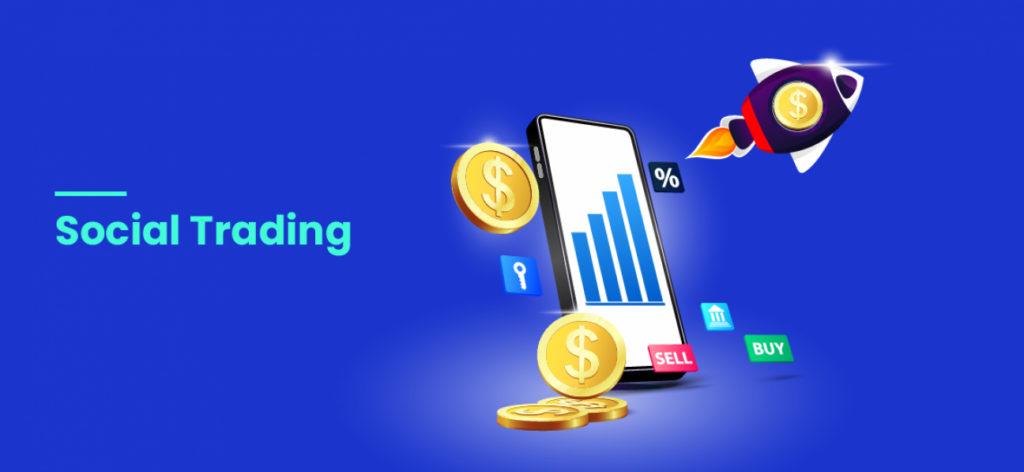Social trading is a form of social investment that allows you to benefit from the knowledge and experience of successful traders. This platform enables you to observe the performance of other traders, learn their strategies, and even automatically copy their trades.
Imagine you’ve entered a busy, unfamiliar market. Social trading is like having an experienced guide by your side, helping you navigate and make informed decisions.
However, social trading is not limited to blindly copying others’ trades. This platform also provides a space for interaction and learning. You can connect with successful traders, ask questions, and learn from their experiences. This helps you gain a better understanding of the market and, ultimately, become a skilled trader yourself.
The Difference Between Social Trading and Copy Trading: On the Right Path to Investment
In the world of investing, new methods for earning profits and managing capital are emerging. Social trading and copy trading are among these methods that, despite their similarities, operate quite separately from each other. Understanding these differences is crucial for selecting the right approach to investing and achieving your financial goals.
Social trading focuses on building a community where traders can share insights, strategies, and experiences, allowing participants to learn from each other. Users can engage with successful traders, ask questions, and gain knowledge about market trends.
On the other hand, copy trading involves directly replicating the trades of a specific trader. This means that when the trader makes a trade, it is automatically executed in the follower’s account. While copy trading can provide a straightforward way to invest based on the decisions of experienced traders, it lacks the interactive learning aspect found in social trading.
Recognizing these distinctions will help you choose the most suitable method for your investment journey and align with your financial objectives.
Social Trading: A Network for Inspiration
Social trading can be likened to a social network for traders. In these platforms, individuals can share their trading performance, discuss their strategies, and learn from each other’s experiences. This environment offers a valuable opportunity for newcomers in the financial markets to enhance their knowledge and skills by observing the performance of successful traders.
Copy Trading: Automated Trade Replication
Copy trading is a more direct method of benefiting from the knowledge and skills of experienced traders. In this approach, you automatically replicate the trades of a specific trader in your account. In other words, every buy and sell executed by the chosen trader is simultaneously mirrored in your account.
Choosing between social trading and copy trading depends on your knowledge, experience, and risk tolerance. Social trading is suitable for those who want to enhance their skills and knowledge by learning from successful traders while maintaining greater control over their trades. Copy trading, on the other hand, is ideal for inexperienced newcomers who prefer to delegate trading decisions to a skilled individual.
However, it’s important to remember that success in both methods relies on selecting the right trader and managing risk effectively.

Advantages and Disadvantages of Social Trading
One of the main advantages of social trading is access to valuable knowledge and experience. By following successful traders, you can draw inspiration from their strategies and decisions. This inspiration does not mean blind copying; rather, it involves learning how to analyze the market, identify investment opportunities, and manage risk.
Another benefit of social trading is the reduction of investment risk. By observing the performance of experienced traders, you can avoid common mistakes. For example, if you notice that a successful trader incurred losses due to neglecting fundamental analysis, you can use this insight to improve your own decision-making process.
Additionally, social trading helps strengthen your trading skills. By reviewing the analyses and decisions of other traders, you can enhance your knowledge and abilities in market analysis and pattern recognition. Over time, this will help you become an independent and successful trader.
However, social trading is not without its challenges. One of its drawbacks is the lack of guaranteed success. A trader’s past performance does not guarantee their future success. Various factors, ranging from macroeconomic conditions to market volatility, can impact trading performance. Therefore, simply following a successful trader does not equate to assured profits.
Another disadvantage of social trading is the need for analytical knowledge. To use this method effectively, you must be able to analyze the performance and strategies of traders well. Distinguishing between successful strategies and misleading signals requires foundational knowledge and skills in financial market analysis.
Additionally, you may encounter false signals and analyses. Unfortunately, some individuals in the social trading space offer incorrect signals and promote illogical methods for quick profits. Thus, it is essential to approach such signals with skepticism and verify the information from credible sources.
In conclusion, social trading is a valuable tool for enhancing trading knowledge and skills. However, it’s important to remember that this method is not a guaranteed key to success. By considering the advantages and disadvantages of social trading, you can use this space to improve your knowledge and make more informed decisions in the financial markets. Keep in mind that success in the investment world requires knowledge, proper risk management, and, of course, a bit of patience and foresight.
Diving into the World of Social Investing: A Guide to Social Trading
The world of investing has always been accompanied by ambiguity and complexity. Analyzing financial markets, selecting the right stocks, and making split-second decisions can be challenging for both newcomers and seasoned investors. With the emergence of new technologies, innovative methods for entering this realm and generating profits have developed. Social trading is one such innovative approach that creates a social space, bringing investors closer together.
In this article, we will explore how social trading works and its advantages for individuals at various levels of investing experience.
Step One: Choosing the Right Platform
The first step to entering the world of social trading is selecting a reliable and user-friendly platform. These platforms are essentially specialized social networks for investment. They allow you to register, create a user account, and view the performance of other traders. Some of these platforms offer additional features such as connecting with traders, sharing analyses and trading strategies, and even automatically copying trades.
Step Two: Finding Successful Traders
After selecting a platform, the next step is to find traders whose performance inspires you. At this stage, pay close attention to their trading history, profit and loss records, the strategies they employ, and their risk tolerance. Remember that past impressive performance does not guarantee future success. Therefore, it is crucial to choose experienced traders with a consistent track record and clear strategies.
Step Three: Analysis and Learning
One of the most important aspects of social trading is the opportunity to analyze and learn from the performance of successful traders. By examining the trades executed, the decisions made, and the analyses provided by these traders, you can enhance your knowledge and skills in financial market analysis and trading decision-making. Over time, by modeling successful strategies and understanding the factors influencing experienced traders’ decisions, you will be able to participate in financial markets with greater confidence.
Step Four: Capital Management and Risk Control
While social trading can be inspiring and beneficial, it’s essential to remember that the final responsibility for investing lies with you. Keep in mind that every trader has their own unique style and strategy, and past performance does not guarantee future success. Therefore, always adhere to the principles of capital management and risk control. Allocate only a portion of your capital to trades based on social trading, and never expose your entire asset base to risk.

Social Trading: A Bridge Between Beginners and Professionals
Social trading creates an environment for knowledge and experience exchange, providing a valuable opportunity for newcomers to the investment world to take solid initial steps by learning from successful traders. At the same time, this method is also beneficial for experienced traders. They can share their knowledge and strategies, helping others while also reaping the benefits of this social network.
This collaborative approach fosters a community where both beginners and seasoned traders can grow, enhancing their skills and expanding their understanding of the market together.
Social Trading in Iran: A Growing Perspective
Social trading, an emerging phenomenon in the investment world, has recently garnered attention in Iran. With the rise of online platforms and increased internet access, interest in financial markets among Iranians has been on the rise. In this context, social trading can serve as an effective tool for inexperienced individuals to take their initial steps in this field by leveraging the knowledge and experience of professional traders.
Challenges Facing Social Trading in Iran
Despite the existing potential, social trading in Iran faces several challenges. One of the main obstacles is the lack of appropriate financial and legal infrastructure for the operation of reputable international platforms in this domain. Currently, only a limited number of domestic platforms offer social trading features, and these platforms often lack the diversity of features and trader credibility found in international counterparts.
Additionally, there is a significant lack of public knowledge and awareness regarding financial markets. A considerable portion of the Iranian population is not sufficiently familiar with how financial markets operate and the associated risks. This situation can lead to the exploitation of uninformed individuals and their reliance on illogical investment methods.
Infrastructure Limitations
Access to fast and stable internet is essential for successful participation in financial markets. Unfortunately, in some regions of the country, this access is plagued by disruptions, which can negatively impact real-time decision-making in trades.
Regulations and Financial Laws
The laws and regulations governing Iran’s financial markets have always been subject to changes and ambiguities. This uncertainty can adversely affect users’ trust in social trading platforms and their willingness to engage in this area. The lack of a clear regulatory framework can deter potential investors from participating, hindering the growth of social trading in the country.
The Future of Social Trading in Iran
Despite the existing challenges, the outlook for social trading in Iran is promising. The increasing penetration of the internet, the growth of financial literacy, and the development of related IT infrastructure will create opportunities for reputable domestic and international platforms to operate in the near future.
In this context, it is essential to focus on the following aspects.
Education and Awareness:
Regulatory bodies and NGOs play a crucial role in enhancing public knowledge and awareness regarding investing and its associated risks. By conducting educational courses and providing comprehensive information, potential issues arising from uninformed individuals entering this field can be mitigated.
Development of Financial and IT Infrastructure:
Establishing the necessary infrastructure for the safe and secure operation of social trading platforms is a significant step towards building user trust and fostering growth in this emerging industry.
Creating a Transparent Legal Framework:
Drafting clear and up-to-date laws and regulations in the realm of social trading will facilitate the legal operation of platforms and help prevent potential abuses. This regulatory clarity is essential for instilling confidence in users and promoting a healthy trading environment.
The Cost of Using This Method for Income
Social trading is a novel approach to entering the world of investment. But does using this method for income come with costs? The answer to this question depends on several key factors, which we will explore in this section.
- Platform Fees:
Many social trading platforms charge fees for their services. These fees can be a percentage of trading profits, a fixed amount per trade, or a combination of both. The fees charged by platforms may vary based on the type of user account (standard, professional, etc.), trading volume, and other factors.
It’s important to pay special attention to the fee structure of a social trading platform and compare it with other platforms before registering. Choosing a platform with reasonable fees can significantly impact your profitability in the long run.
- Additional Costs and Analysis:
Success in social trading is not solely dependent on blindly copying others’ trades. Careful analysis of traders’ performance, reviewing their strategies, and aligning them with your risk tolerance and financial goals is crucial.
To conduct more detailed analyses, you may need to use technical or fundamental analysis tools. Some of these tools are free, while others may require a monthly or annual subscription fee.
Additionally, some social trading platforms offer consulting services and trading signals to their users. Utilizing these services may incur extra costs for you.
The final decision regarding the use of analysis tools, consulting services, or trading signals depends on your level of knowledge and skills, as well as the budget you have allocated for investing.
- Brokerage Fees
Don’t forget that the process of buying and selling assets in financial markets is conducted through brokers. Brokers also charge fees for executing your transactions.
The fees charged by brokers can vary based on the type of asset being traded (stocks, currencies, commodities, etc.), the volume of the trade, and the broker’s fee structure.
Comparing the fees of different brokers and choosing one with reasonable fees can ultimately help increase your profitability in social trading.
The cost of using social trading for income encompasses a variety of factors, including platform fees, additional analysis costs, and brokerage fees. By choosing a platform with reasonable fees, effectively managing additional costs, and comparing brokerage fees, you can significantly reduce the overall cost of entering the world of social trading.

Is Social Trading Safe? Transitioning from Doubt to Trust
The first step to safely entering the world of social trading is selecting a reliable platform. Reputable platforms have legal licenses from recognized regulatory bodies. These entities oversee platform activities and ensure the protection of user rights and the security of their investments. Therefore, before starting to operate on any social trading platform, it is essential to verify its credibility and licenses.
Understanding Traders: A Guarantee for Making the Right Choice
In social trading, your success largely depends on the careful selection of the traders you wish to emulate or copy. Reputable platforms provide comprehensive information about the trading history, strategies, and risk tolerance of each trader. By thoroughly reviewing this information, you can ensure that the trader’s qualifications and strategies align with your own goals and risk tolerance.
Keep in mind that past performance does not guarantee future success. However, evaluating trading records will assist you in making an informed choice.
Accountability in Social Trading
It’s important to remember that the final decision for investing always rests with you. Social trading is a tool for learning and modeling successful traders. This does not mean that the responsibility for the outcomes of trades lies with another trader. Always make your final decision to enter or exit trades based on your own risk tolerance and market conditions.
Types of Social Trading Methods
In social trading, there are various methods to leverage the knowledge and experience of professional traders. In this article, we will introduce and explain some of the most common social trading methods.
- Copy Trading:
Copy trading is one of the simplest and most popular methods of social trading. In this approach, you select traders whose performance and strategies you appreciate. Then, the social trading platform automatically copies their trades to your account. In other words, every buy and sell executed by your chosen trader is simultaneously replicated in your account. This method is particularly suitable for inexperienced investors looking to model successful traders.
- Mirror Trading:
Mirror trading shares similarities with copy trading, but differs in that it reflects the entire portfolio of the selected trader as a percentage in your account. This means that, in addition to copying trades, the proportion of the trader’s investment in each asset is maintained in your account. This method is suitable for investors with moderate risk tolerance who wish to allocate their capital similarly to their chosen trader.
- Signal Trading:
Signal trading is a method where professional traders provide buy and sell signals to users. These signals may include information such as the type of asset, entry and exit prices, and stop-loss levels. Users receive these signals and make their final trading decisions based on their own analysis and risk tolerance. This method is ideal for more active investors looking for trading ideas from experts.
- Social Media:
With the expansion of social networks, some professional traders provide trading signals and share their knowledge and experience through analyses published on social media. Investors can benefit from following these individuals and their analyses in their trading decisions. However, it is crucial to carefully assess the credibility and track records of these analysts.
- Mirror Portfolio:
Some social trading platforms offer the option for professional traders to manage funds through a “mirror portfolio.” In this method, investors allocate their funds to a portfolio managed by their chosen trader. The professional trader takes responsibility for managing the entire portfolio according to the defined strategy and risk tolerance. This method is suitable for inexperienced investors who lack the time to analyze the market; however, selecting a skilled trader and reviewing their track record is essential.
Each of these social trading methods has its own advantages and disadvantages. Choosing the right method depends on your level of knowledge, experience, risk tolerance, and investment goals. Before entering the world of social trading, it is important to familiarize yourself with the various methods, their benefits, and drawbacks, and to adopt a cautious and responsible approach to leverage this tool for improving your performance in financial markets.
Final Thoughts
The social trading platform can be likened to a social network for traders. In these platforms, individuals can share their trading performance publicly or privately, discuss their strategies, and learn from each other’s experiences. This environment allows newcomers to the market to enhance their knowledge and skills in market analysis and trading decisions by observing the performance of successful traders.



